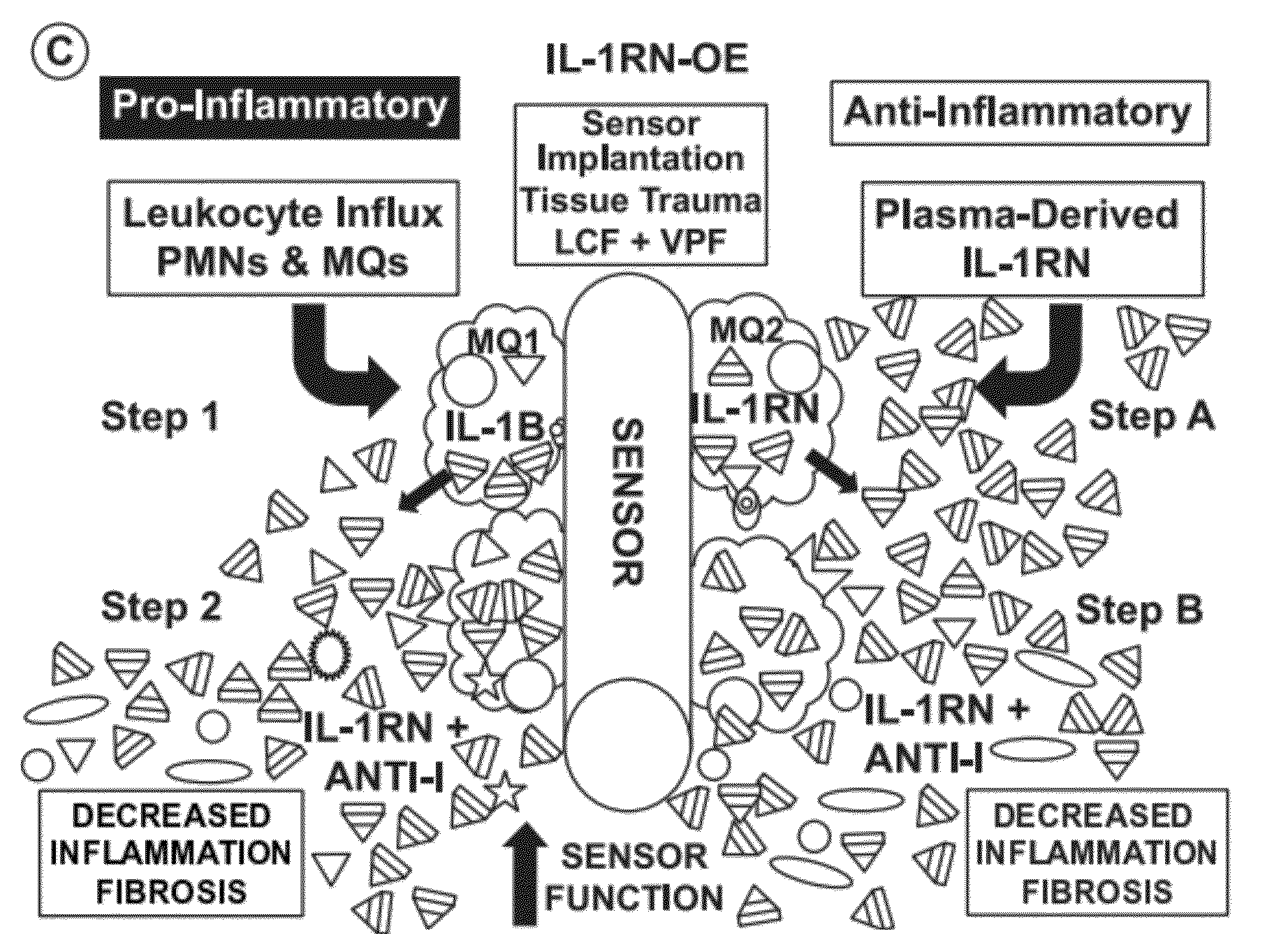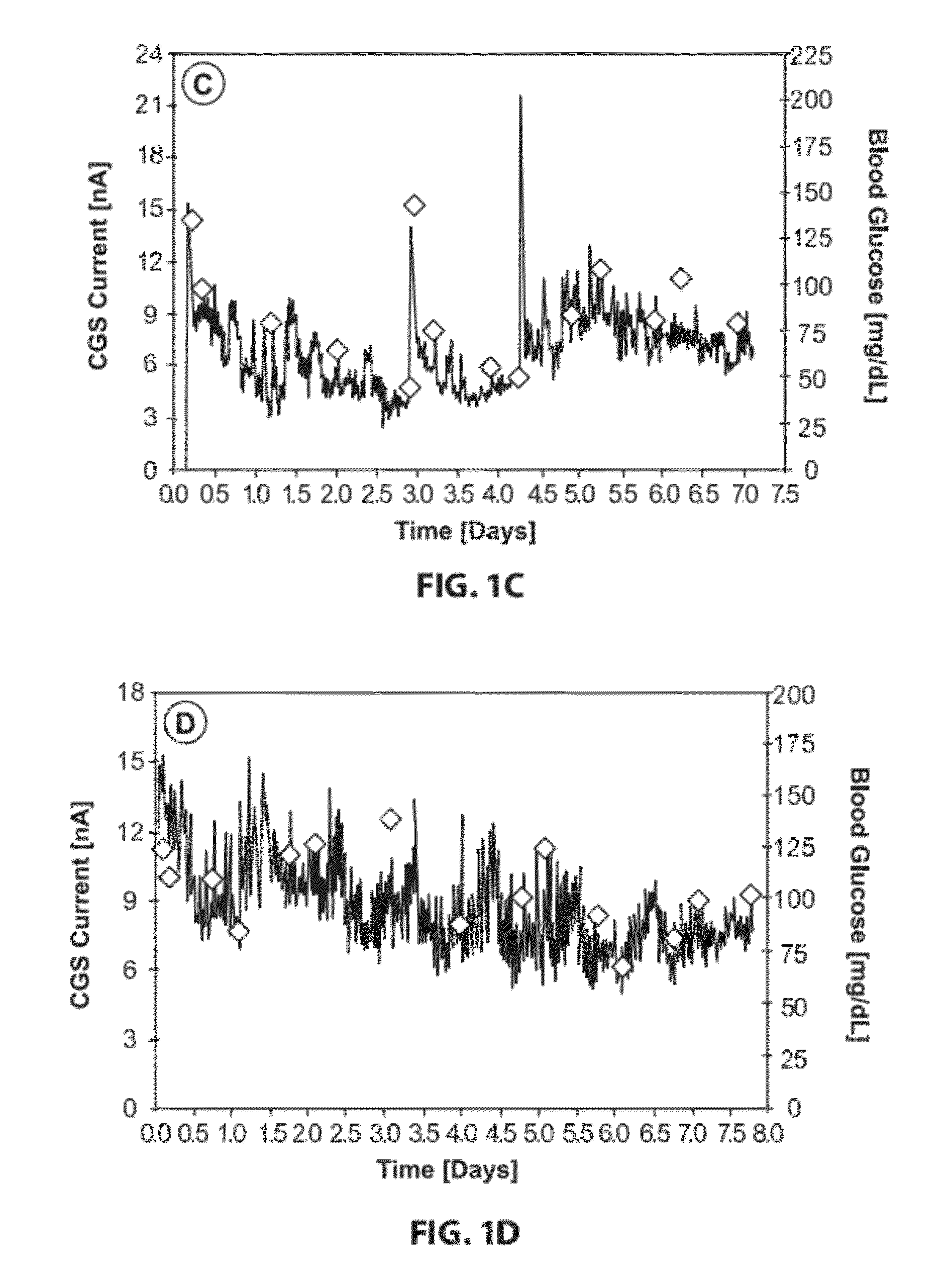Systems and Methods for Improved In Vivo Analyte Sensor Function
a technology function, which is applied in the field of systems and methods for improving the function of in vivo analyte sensor, to achieve the effect of improving the performance of one or more components, improving signal response and stability
- Summary
- Abstract
- Description
- Claims
- Application Information
AI Technical Summary
Benefits of technology
Problems solved by technology
Method used
Image
Examples
example 1
Glucose Sensor Function in Normal Mice (C57BL / 6)
Continuous Glucose Monitoring in Normal Mice
[0174]Tissue responses to an implanted sensor may become increasingly more important as the implantation period is increased. In order to achieve long-term glucose sensing, the severity of the tissue reaction occurring in the initial phase of sensor implantation (e.g., tissue injury) may have an impact on the tissue repair at site of sensor implantation. Therefore, experiments were performed to study potential mediators and mechanisms that control sensor related tissue reactions within the first 7 days post implantation. A murine model of continuous glucose monitoring (CGM) was used. Since the Interleukin 1 family of cytokines mediates inflammation and repair, the role of IL-1 / IL-1RN in glucose sensing was investigated using genetically engineered mice, which lack IL-1RN (e.g., IL-1RN-KO knockout mice) or over-express IL-1RN (e.g., IL-1RN-OE mice). Experiments were also performed on CGM in no...
example 2
Glucose Sensor Function in IL-1RN Knockout Mice
Continuous Glucose Monitoring in Interleukin 1 Receptor Antagonist Knockout Mice
[0176]Because of the pro-inflammatory and pro-fibrotic activity of IL-1B, removing IL-1 antagonist, IL-1RN, expression in vivo, may allow over expression of pro-inflammatory activity of locally produced IL-1B, resulting in enhanced inflammation and fibrosis and decreased glucose sensor function. The experiments demonstrated that deficiency of IL-1RN in IL-1RN-KO mice resulted in an increase in inflammation at the site of sensor implantation (FIGS. 3A-H and FIG. 4), which correlated with loss of sensor function within the first few days post sensor implantation (FIG. 2A-H). Sensor functionality was lost typically within the first 24 hours post implantation and in most cases this temporary loss of sensor functionality lasted for the first 2-3 days. The initial implantation of the sensor triggered release of local inflammatory mediators from tissue cells, and p...
example 3
Glucose Sensor Function in IL-1RN Over-Expressing Mice
Continuous Glucose Monitoring in Interleukin 1 Receptor Antagonist Over-Expressing Mice
[0178]CGM experiments that utilized IL-1RN-KO were performed. The experiments showed that IL-1 / IL-1RN plays a role in controlling both tissue reactions and glucose sensor function at sites of sensor implantation. Over-expression of IL-1RN may allow blocking of pro-inflammatory activity of locally produced IL-1B, resulting in decreased inflammation and fibrosis and increased glucose sensor function. The experiments demonstrated that over expression of IL-1RN in IL-1RN-OE mice resulted in an increase in inflammation and fibrosis at the site of sensor implantation (FIGS. 3A-H and 4) when compared to the IL-1RN-KO mice (FIGS. 2A-H). For the 7 day testing period, IL-1RN-OE mice displayed similar sensor function as C57BL control mice. These experiments suggested that a decrease in systemic and / or local IL-1RN expression may cause a decrease in sensor...
PUM
 Login to View More
Login to View More Abstract
Description
Claims
Application Information
 Login to View More
Login to View More - R&D
- Intellectual Property
- Life Sciences
- Materials
- Tech Scout
- Unparalleled Data Quality
- Higher Quality Content
- 60% Fewer Hallucinations
Browse by: Latest US Patents, China's latest patents, Technical Efficacy Thesaurus, Application Domain, Technology Topic, Popular Technical Reports.
© 2025 PatSnap. All rights reserved.Legal|Privacy policy|Modern Slavery Act Transparency Statement|Sitemap|About US| Contact US: help@patsnap.com



